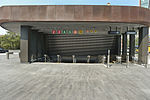Proposed domed Brooklyn Dodgers stadium
The Brooklyn Sports Center, in retrospect known as the Dodger Dome, was a proposed domed stadium for the Brooklyn Dodgers, designed by Buckminster Fuller, that was to replace Ebbets Field for the Brooklyn Dodgers to allow them to stay in New York City. The Dodgers instead moved to Chavez Ravine in Los Angeles. First announced in the early 1950s, the envisioned structure would have seated 52,000 people and been the first domed stadium in the world, opening roughly a decade before Houston's Astrodome. The stadium, in Fort Greene, Brooklyn, would have been located at the northeast corner of Flatbush Avenue and Atlantic Avenue, on the site of the Atlantic Terminal. It would have cost $6 million to build and been privately financed. It was never built. The general area eventually did become a sports venue, because Barclays Center was built across the street to the south from the Atlantic Terminal, in neighboring Pacific Park.
Excerpt from the Wikipedia article Proposed domed Brooklyn Dodgers stadium (License: CC BY-SA 3.0, Authors).Proposed domed Brooklyn Dodgers stadium
Pacific Street, New York Brooklyn
Geographical coordinates (GPS) Address Nearby Places Show on map
Geographical coordinates (GPS)
| Latitude | Longitude |
|---|---|
| N 40.683333333333 ° | E -73.976666666667 ° |
Address
Atlantic Avenue–Barclays Center
Pacific Street
11217 New York, Brooklyn
New York, United States
Open on Google Maps









